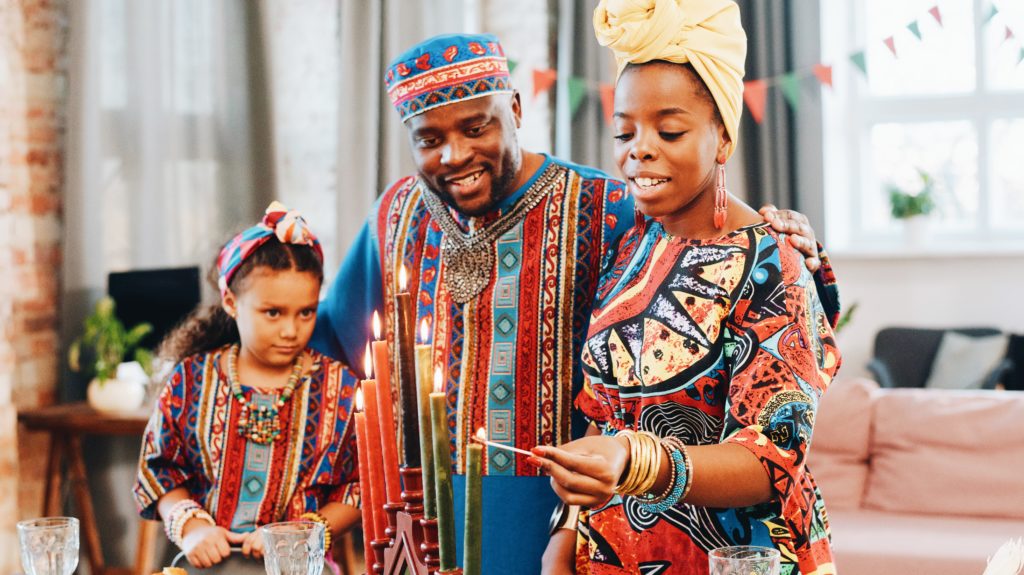Knowing that the name Kwanzaa means “first fruit” should entice any vegan to further explore the holiday. Kwanzaa was first celebrated in 1966 as a way to bring together the Black community and tie back to African roots. It takes cues from historic crop-harvesting festivals held by tribes and nations like Zulu and Ashanti, many of which were mostly or completely plant-based.
Black culture expert Shukrani Gray explains the significance, “Kwanzaa was created to reclaim some connection to African culture. People say that’s not ‘real’ African, just made up African. What they ignore is the fact that Black Americans have been trying to reconnect with something that felt like home. We use Swahili terms, even though the majority of Black people came through the slave trade from West Africa.”
Because of slavery, most Black Americans are disconnected from what it means to be African. Very few traditions have been retained, and many don’t know their countries of origin. That is why Kwanzaa blends customs from various countries and culture groups within Africa.

The 7 Principles of Kwanzaa
Kwanzaa has seven principles, and combined, they encourage kindness and smart, sustainable living that empowers others.
Umoja (unity)
This means that we should strive for unity within our families and communities.
Kujichagulia (self-determination)
This calls for individuality and goals.
Ujima (collective work and responsibility)
This means that we should take care of each other.
Ujamaa (cooperative economics)
This encourages us to support Black businesses.
Nia (purpose)
This reminds us of the importance of embodying a mission that impacts the greater good of society.
Kuumba (creativity)
This encourages us to leave the world more beautiful than we found it and reduce our negative footprint.
Imani (faith)
Finally, Imani calls for us to believe in our communities and the victory that comes from perseverance.
These principles easily fall in line with veganism, and our responsibilities to treat the earth kindly, as well as seven symbols. These are incorporated into the celebration. The candleholder or “kinara” is lit nightly. And it represents ancestral roots.
The candles are the color of the Black pride flag — one for each principle. Celebrants place fruits, nuts, and vegetables on a mat (the foundation), and they symbolize the harvests. There is an ear of corn for each child since they symbolize fertility. The final symbol is the unity cup. Everyone takes a sip from it, in honor of the ancestors and for unity.
The foods of Kwanzaa
On the sixth and last day of Kwanzaa, there is a feast. It is an opportunity to celebrate the origins of soul food, which has traveled from Africa through slavery. Traditional dishes include sweet potatoes (yams), squash, okra, bananas, and plantains. Dinner may also feature African foods such as jollof rice, and stew is the centerpiece. The type varies depending on where the meal could take place. (For instance, Southerners might have gumbo, or someone from the islands may have a plantain stew.)
Afro-Latina food blogger Denise Santa Maria has spent the year on a quest to recreate vegan versions of the food she grew up on. Her website Hispanic-ish.com offers vegan versions of sancocho, a Dominican beef stew with roots back to Africa, as well as garlic tostones. Both of these can easily fit into a Kwanzaa feast.
Gray, the African American Resource Collection, Equity and Inclusion Librarian at New Orleans Public Library, has been celebrating Kwanzaa her entire life. “The way we used to celebrate would be to go to someone’s house, or to a small community organization for each day of Kwanzaa. You’d celebrate with other families, and you’d speak to the principal of the day, and you’d light the kinara.” For years, her hometown of Chicago held city-wide festivities to celebrate the principle Imani, or faith.
Veganism has origins in Black culture
Gray vacillates between vegan and pescetarian. She recommends taking advantage of a library to learn. And no matter her preference, she is able to feast like everyone else. The reasoning for this is the afrocentrism embodied by Chicagoans.
She explains, “Part of that movement was being healthier, dating back to the 70s and 80s. That’s when Black people started opening health food stores and becoming vegetarian. So it’s no wonder that that has always been a part of the Kwanzaa celebration. I think anywhere that you go in the United States, if you go to a Kwanzaa celebration, you’re going to have a vegan or vegetarian option.”
Gray explains that Thanksgiving and Christmas were “problematic” holidays, and she’d often leave parties hungry. However, Kwanzaa partygoers always have fresh juice, brown rice, veggies, and popcorn with nutritional yeast to snack on.
This year, COVID has halted citywide celebrations. Juanta Griffin also hails from Chicago. She says that the pandemic has thwarted the city’s efforts to educate the community about Kwanzaa. “I am the multicultural learning coordinator for Oak Park Public Library. And we have Kwanzaa kits that are not in circulation this year due to COVID-19.”
The kits contained reading materials and a kinara. Griffin is finalizing a Kwanzaa documentary, which will help to close the learning gap this year. She encourages those who want to experience the plant-based aspects of the holiday to focus on the harvest foods, including “muhindi”, or corn. “The corn represents the number of children in the home.”
For those who want to try their hand at cooking foods typically served at Kwanzaa dinners, vegan chef and food blogger Prahkeet Miykhael has created vegan recipes for Southern black-eyed peas and collard greens, which is a Kwanzaa and New Year’s Eve tradition in Black and Southern communities for luck and prosperity in the new year. You can find that recipe here.


